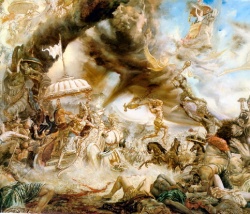Abhidhamma Pitaka
The Abhidhamma Pitaka (abhidhammapiṭaka) is the last of the three pitakas (Pali for "baskets") constituting the Pali Canon, the scriptures of Theravāda Buddhism.
The Abhidhamma Pitaka is the third division of the Tipitaka, the sacred scriptures of Buddhism, the other parts being the Sutta Pitaka and the Vinaya Pitaka. It is made up of seven books – the Dhammasaïgani, the Vibhaïga, the Dhàtukathà, the Puggalapa¤¤atti, the Kathàvatthu, the Yamaka and the Paññhàna. An eighth book called the Mahàdhammahadaya has been lost. All the books of the Abhidhamma Piñaka are later than both the Sutta and the Vinaya Pitakas and may have been composed several hundred years
after the Buddha’s passing. Tradition attributes them all to the Buddha himself but there is no mention of this in the Abhidhamma Pitaka itself nor is there any mention of the Abhidhamma Pitaka in either the Sutta or the Vinaya Pitakas. However, there is nothing in the Abhidhamma Pitaka that contradicts the Buddha’s teachings; the difference is of approach, not content. See also: Abhidhamma.
The Abhidhamma Pitaka is a detailed scholastic reworking of material appearing in the Suttas, according to schematic classifications. It does not contain systematic philosophical treatises, but summaries or enumerated lists'
Translations
The first five Books and part of the seventh of The Abhidhamma Pitaka have been translated by the Pali Text Society, which offers an option to order them through their website.
Nature of Abhidhamma
Abhidhamma has been variously described as philosophy, psychology, metaphysics etc. L. S. Cousins says that the Abhidhamma methodology looks at things in terms of occasions or events instead of sequences or processes.
Origins
Tradition holds that The Buddha Thought the Abhidhamma out immediately after his Enlightenment then taught it to the gods some years later. Later The Buddha repeated it to Sariputta who then handed it on to his disciples. This tradition is also evident in the Parivara, a very late addition to the Vinaya Pitaka,which mentions in a concluding verse of praise to The Buddha that this best of creatures, the lion, taught the three pitakas..
Scholars, however, generally date the Abhidhamma works to originating some time around the third century BCE, 100 to 200 years after the Death of The Buddha. Therefore the seven Abhidhamma works are generally claimed by scholars not to represent the words of The Buddha himself, but those of disciples and scholars. Dr
Rupert Gethin however said that important elements of Abhidhamma methodology probably go back to The Buddha's lifetime. A. K. Warder and Dr Peter Harvey both suggested early dates for the matikas on which most of the Abidhamma Books are based. Abhidhamma started out as elaboration of the suttas,[dubious – discuss] but later developed independent doctrines.
As the last major division of the canon, The Abhidhamma Pitaka has had a checkered history. It was not accepted as canonical by the Mahasanghika school and several other schools[dubious – discuss]. Another school included most of the Khuddaka Nikaya within The Abhidhamma Pitaka. Also, the Pali version of the Abhidhamma is a strictly Theravada collection, and has little in common with the Abhidhamma works recognized by other Buddhist schools.[ The various Abhidhamma philosophies of the various [[early
schools]] have no agreement on doctrineand belong to the period of 'Divided Buddhism' (as opposed to Undivided Buddhism). The earliest texts of the Pali Canon have no mention of (the texts of) the Abhidhamma Pitaka.] The
Abhidhamma is also not mentioned in some reports of the First Buddhist Council, which do mention the existence of the texts of the Vinaya and either the five Nikayas or the four Agamas. Other accounts do include the Abhidhamma.
In the Theravadin Abhidhamma Pitaka, unlike the Abhidharma Pitaka of the Sarvastivada school, ontological theorizing is absent, and the question of ontological status of dharmas remains a moot point. The notion of sabhava (Sanskrit: Svabhava) is only utilized in late Theravadin texts. The Doctrine of momentariness is also a late addition to Theravada Thought. It only appears at the time of Buddhaghosa.
Contents
The Abhidhamma Pitaka consists of seven Books:
- Dhammasangani (-saṅgaṇi or -saṅgaṇī)
- Vibhanga (vibhaṅga)
- Dhatukatha (dhātukathā)
- Puggalapannatti (-paññatti)
- Kathavatthu (kathā-)
- Yamaka
- Patthana (paţţhāna)
Dhammasangani
The Dhammasangani begins with a mātikā (translated as matrix) which lists classifications of dhammas (translated as Phenomena, ideas, states, etc.). The mātikā starts with 22 threefold classifications, such as good/bad/unclassified, and then follows with 100 twofold classifications according to the Abhidhamma method. Many of
these classifications are not exhaustive, and some are not even exclusive. The mātikā ends with 42 twofold classifications according to the Sutta method; these 42 are only used in the Dhammasangani, whereas the other 122 are used in some of the other Books as well.
The main Body of the Dhammasangani is in four parts. The first part goes through numerous states of Mind, listing and defining by lists of synonyms, factors present in the states. The second deals with material Form,
beginning with its own mātikā, classifying by ones, twos and so on, and explaining afterwards. The third explains the book's mātikā in terms of the first two parts, as does the fourth, by a different method (and omitting the Sutta method).
Vibhanga
The Vibhanga consists of 18 chapters, each dealing with a different topic. For example the first chapter deals with The five aggregates. A typical chapter consists of three parts. The first of these parts explains the topic according to the Sutta method, often word-for-word as in actual suttas. The second is Abhidhamma explanation, mainly by lists of synonyms as in the Dhammasangani. The third employs questions and answers, based on the mātikā, such as "How many Aggregates are good?"
Dhatukatha
This book covers both the matika and various topics, mostly from the Vibhanga, relating them to the 5 Aggregates, 12 bases and 18 elements. The first chapter is fairly simple: "In how many Aggregates etc. are good dhammas etc. included?" The book progressively works up to more complicated questions: "From how many Aggregates etc. are the dhammas dissociated from attention etc. dissociated?"
Puggalapannatti
This book starts with its own matika, which begins with some standard lists but then continues with lists of persons grouped numerically from ones to tens. This latter portion of the matika is then explained in the main Body of the work. Most of the lists of persons and many of the explanations are also found in the Anguttara Nikaya.
Kathavatthu
This book consists of more than two hundred Debates on questions of Doctrine. It does not identify the participants. The commentary says the Debates are between the Theravada and other schools, which it identifies in each case. These identifications are mostly consistent with what is known from other sources about the doctrines of different schools.
Yamaka
This book consists of ten chapters, each dealing with a different topic; for example, the first deals with roots. A typical chapter (there are a number of divergences from this pattern) is in three parts. The first part deals with questions of identity: "Is good root root?" "But is root good root?"
The entire Yamaka consists of such pairs of converse questions, with their answers. Hence its name, which means pairs. The second part deals with arising: "For someone for whom the Form Aggregate arises, does the Feeling Aggregate arise?" The third part deals with understanding: "Does someone who understands the eye base understand the ear base?"
Patthana
This book deals with 24 conditions in relation to the matika: "Good Dhamma is related to good Dhamma by root condition", with details and numbers of answers.
Place in the tradition
The importance of The Abhidhamma Pitaka in classical Sinhalese Buddhism is suggested by the fact that it came to be furnished, not only, like much of the canon, with a commentary and a subcommentary on that commentary, but even with a subsubcommentary on that subcommentary. In more recent centuries, Burma has become the main centre of Abhidhamma studies.
Explanation from buddhisma2z.com
The Abhidhamma Piṭaka is the third division of the Tipiṭaka, the sacred scriptures of Buddhism, the other parts being the Sutta Piṭaka and the Vinaya Piṭaka. It is made up of seven Books – the Dhammasaṅgani, the Vibhaṅga, the Dhātukathā, the Puggalapaññatti, the Kathāvatthu, the Yamaka and
the Paṭṭhāna. The Books of the Abhidhamma Piṭaka are generally later than both the Sutta and the Vinaya Piṭakas and may have reached their present Form several hundred years after The Buddha’s passing. Tradition attributes them all to The Buddha, but there is no mention of this in the Abhidhamma Piṭaka
itself, nor is there any mention of the Abhidhamma Piṭaka in either the Sutta or the Vinaya Piṭakas. However, there is nothing in the Abhidhamma Piṭaka that contradicts The Buddha’s teachings; the difference is of approach, not content. See Abhidhamma and Saṅkassa.
Higher Dhamma, pertaining to dhammas, basket of the Tipitaka
It is made up of seven books – the Dhammasaïgani, the Vibhaïga, the Dhàtukathà, the Puggalapa¤¤atti, the Kathàvatthu, the Yamaka and the Paññhàna. An eighth book called the Mahàdhammahadaya has been lost.
- Dhammasangani ("Enumeration of Phenomena"). This book enumerates all the paramattha dhamma (ultimate realities) to be found in the world.
- Vibhanga ("The Book of Treatises"). This book continues the analysis of the Dhammasangani, here in the form of a catechism.
- Dhatukatha ("Discussion with Reference to the Elements"). A reiteration of the foregoing, in the form of questions and answers.
- Puggalapannatti ("Description of Individuals"). Somewhat out of place in the Abhidhamma Pitaka, this book contains descriptions of a number of personality-types.
- Kathavatthu ("Points of Controversy"). Another odd inclusion in the Abhidhamma, this book contains questions and answers that were compiled by Moggaliputta Tissa in the 3rd century BCE, in order to help clarify points of controversy that existed between the various early schools of Buddhism at the time.
- Yamaka ("The Book of Pairs"). This book is a logical analysis of many concepts presented in the earlier books. In the words of Mrs. Rhys Davids, an eminent 20th century Pali scholar, the ten chapters of the Yamaka amount to little more than "ten valleys of dry bones."
- Patthana ("The Book of Relations"). This book, by far the longest single volume in the Tipitaka (over 6,000 pages long in the Siamese edition), describes the 24 paccayas, or laws of conditionality, through which the dhammas interact. These laws, when applied in every possible permutation with the dhammas described in the Dhammasangani, give rise to all knowable experience



